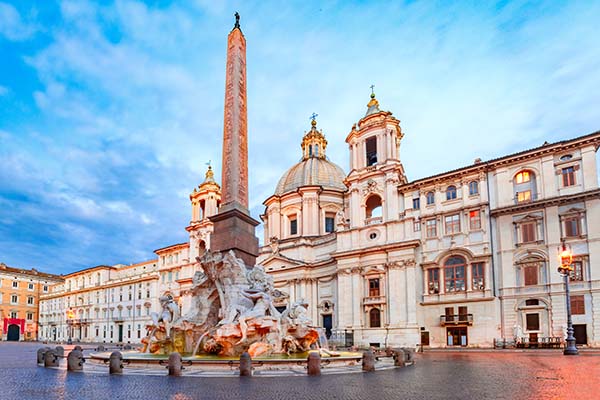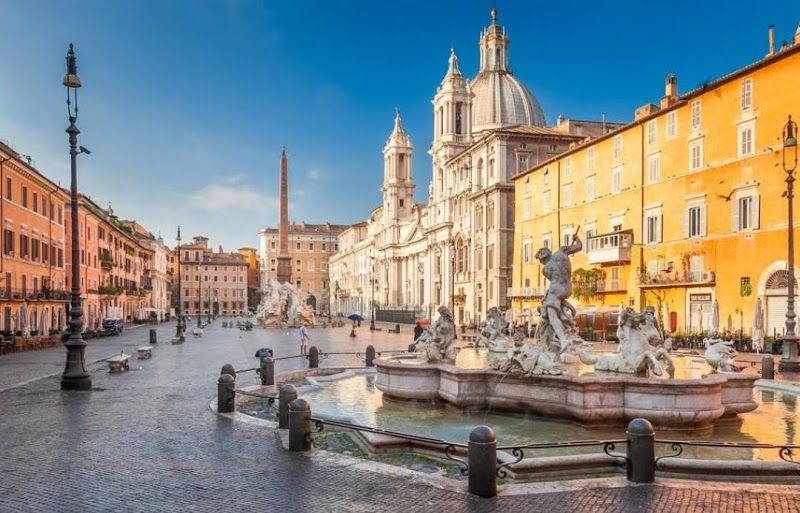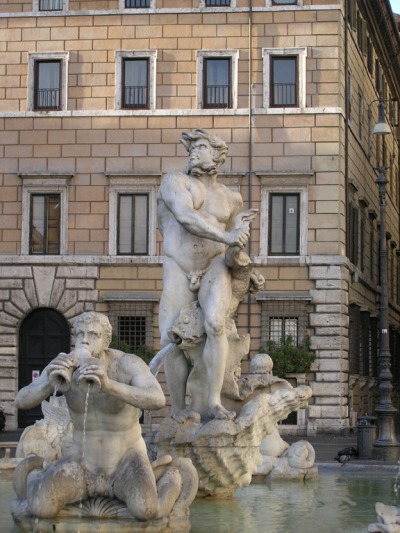
Piazza Navona was defined as a public space at the end of the 15th century. It was where the public market was transferred from the Campidoglio. Piazza Navona was transformed into a highly significant example of Baroque Roman architecture and art during the pontificate of Innocent X. Innocent’s family’s palace, the Palazzo Pamphili, faced the piazza as well as the church of Sant’Agnese in Agone which Innocent was the sponsor of. Very influential artists of the Baroque period were tasked with these designs. Among these were Gian Lorenzo Bernini, Francesco Borromini,Giacomo Della Porta, and Antonio Della Bitta. Each of these artists contributed to different elements of the piazza.
Throughout history, the piazza has been used as a location to host markets, theatrical performances, carnivals, and even a filming location for several movies more recently. Each year there is a Christmas market is held in the piazza square that is one of the largest events of the season.
In the center stands the famous Fountain of the Four Rivers designed 1651 by Gian Lorenzo Bernini and was topped by the Obelisk of Domitian, brought in pieces from the Circus of Maxentius. This fountain is meant to represent the four major rivers of the four continents through which papal authority had spread. These rivers are the Nile representing Africa, the Danube representing Europe, the Ganges representing Asia, and the Río de la Plata representing the Americas. The Egyptian Obelisk at the center is a copy and at the top is placed the Pamphili family emblem of a dove with an olive twig. On the rock, at the base of the obelisk, there are four figures that represent four river gods. Each one has animals and plants that further carry forth identification, and each carries a certain number of allegories and metaphors with it.

There are two other fountains located in the Northern and Southern ends. At the southern end is the Fontana del Moro with a basin and four Tritons sculpted by Giacomo Della Porta in 1575. And at the northern end is the Fountain of Neptune also created by Giacomo Della Porta but a year before in 1574. The statue of Neptune, by Antonio Della Bitta, was added in 1878 to create a balance with La Fontana del Moro. These original basin designs by Giacomo Della Porta were sponsored by pope Gregory XIII.



Originally Giacomo Della Porta designed the Fountain of Moor with the dolphin and four Tritons in 1575. Later in 1673, Bernini added a statue of a Moor, wrestling with the dolphin. The fountain currently represents a Moor standing in a conch shell, wrestling with a dolphin, surrounded by four Tritons. It is placed in a basin of rose-colored marble that has an ornate shape.
The Fountain of Neptune was once called “Fontana dei Calderari” because it was located close to a small alley with blacksmith’s workshops, makers of pots and pans, and of other metal-based businesses, all of them generating heat. The basin was designed in 1574 by Giacomo Della Porta although he did not design any statues for this one. The fountain actually survived 300 years without any statues. The fountain as it exists today was finally completed in 1878 by Antonio Della Bitta, who added the imposing sculpture of Neptune fighting with an octopus, and Gregorio Zappalà, who created the other sculptures, based on the mythological theme of the “Nereids with Cupids and walruses.” The lower part of the basin consists of white marble and has the same shape as the Fountain of Moor.

Aside from the Fountains, the Church of Saint Agnes at the Circus Agonalis or Sant’Agnese in Agone can be discussed when talking about Piazza Navona. As I stated in the beginning it was sponsored by Pope Innocent X. He was the one who instigated the building of the Church in the Baroque design. The first designs for a Greek Cross church were prepared by the Pamphili family architect, Girolamo Rainaldi, and his son Carlo Rainaldi in 1652, and in 1653, the Rainaldis were replaced by Borromini.

Today the Piazza Navona is still a powerful example of Baroque architecture in Rome. It is visited as a beautiful spot to rest and it still operates as a market for small shops. This is truly a space to spend hours in to behold with all of its intricate details.
Citation:
- Solomons, Gabriel, ed. 2014. World Film Locations: Rome : Rome. Bristol: Intellect Books Ltd. Accessed November 1, 2021. ProQuest Ebook Central.
- A Companion to Early Modern Rome, 1492-1692, BRILL, 2019. ProQuest Ebook Central, https://ebookcentral.proquest.com/lib/snorcol-ebooks/detail.action?docID=5683599.
- Painter, B.. Mussolini’s Rome: Rebuilding the Eternal City, Palgrave Macmillan US, 2005. ProQuest Ebook Central, https://ebookcentral.proquest.com/lib/snorcol-ebooks/detail.action?docID=307992.